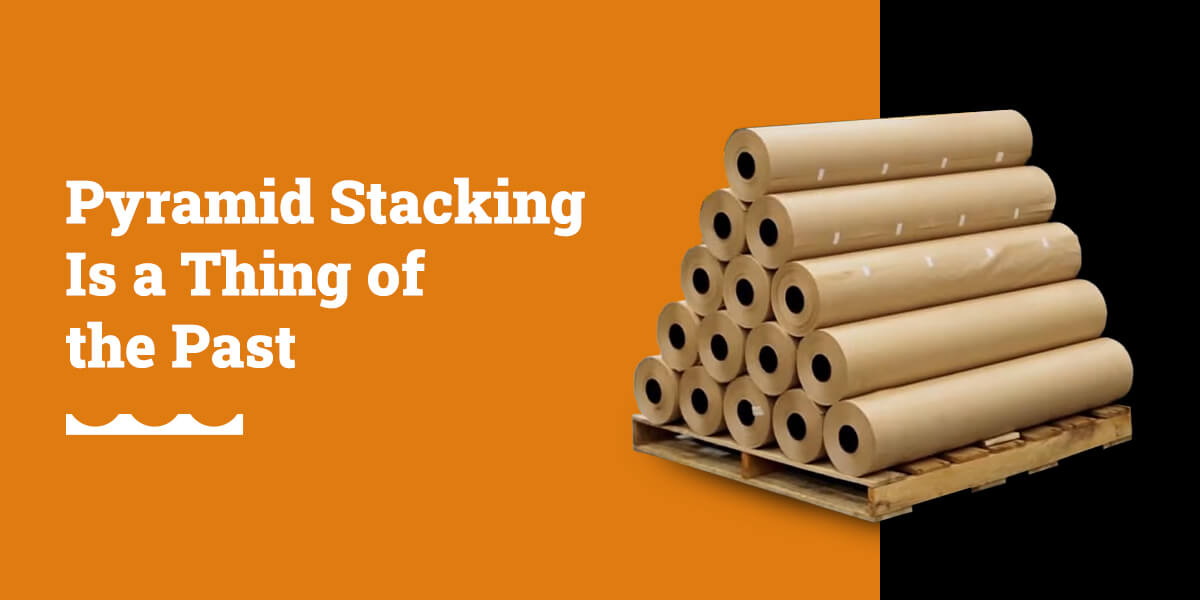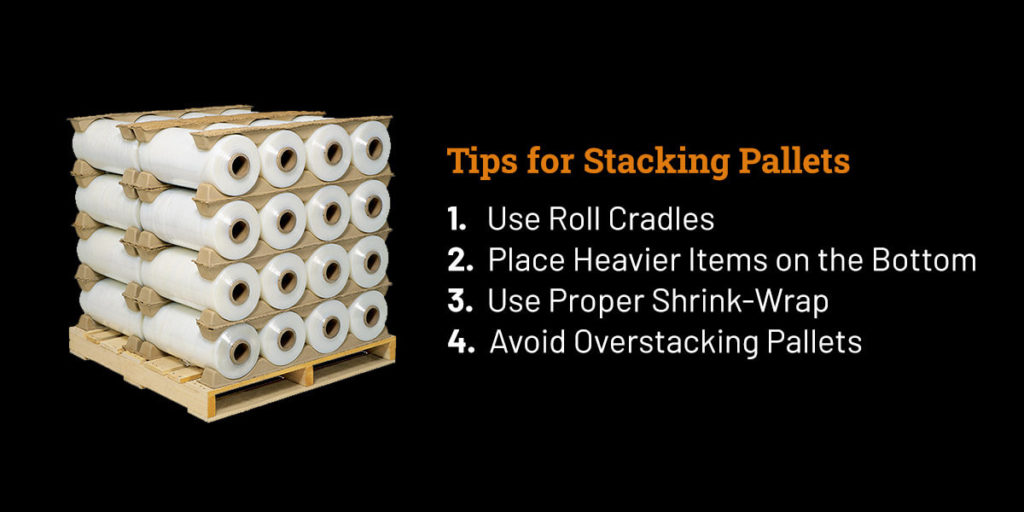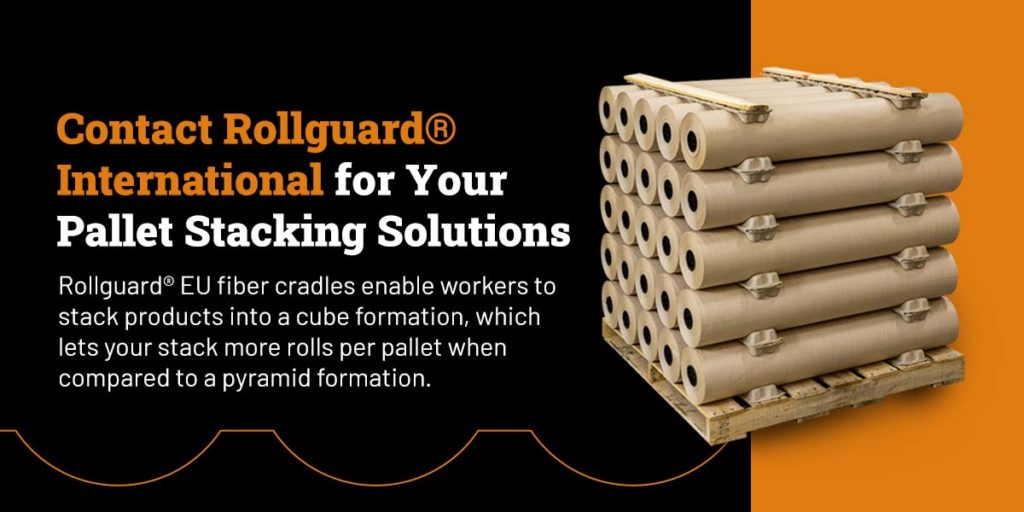Pyramid Stacking is a Thing of the Past
Manufacturers and distributors need robust warehousing solutions to boost efficiency. Using the best pallet stacking method is crucial to keeping products in top shape and making the most of your warehouse space.
- What is Pyramid Stacking
- Why You Shouldn’t Pyramid Stack
- Stacking Pallets With a Cube Formation
- Tips for Stacking Pallets
Pyramid stacking is a traditional warehousing method that distributors often use for cylindrical objects like rolls of material. However, many manufacturers are replacing pyramid stacking with more efficient techniques. Learn about why pyramid stacking pallets is a thing of the past and how to improve your pallet stacking system.
What is Pyramid Stacking
Pyramid stacking for pallets is a warehousing technique of stacking products that places the products in a pyramid shape, with each tier narrower than the one below. Though warehouses can use pyramid stacking with boxes, this system is more popular with cylindrical objects that could otherwise be difficult to stack.
Many industries, from construction to medicine, work with cylindrical objects. Products you might find on a pyramid-stacked pallet include:
- Medical films
- Roll-up doors
- Stretch film
- Mufflers
- Machine parts
- Fabric rolls
- Tape rolls
- Paper rolls
- Agricultural film
Why You Shouldn’t Pyramid Stack
While pyramid loads seem stable because of their wide base, this pallet stacking method can weaken your stack’s structural integrity and lead to several issues.
1. Products Can Fall
Pyramid stacking is not the most secure method for stacking objects on pallets. The products toward the top of the stack have less stability than those at the bottom. Cylindrical objects are prone to rolling off the top of the pallet and may cause the entire stack to collapse. Falling objects can become damaged or even harm nearby workers.
2. Inefficient Use of Space
Since workers can only create so many tiers in a pyramid, they utilize the pallet ineffectively. A pyramid stacking technique means workers can’t stack products directly on top of each other. As a result, they use more pallets to stack the same amount of products.
Pyramid stacking also makes stacking pallets in a warehouse impossible, as they can not be placed on top of one another. Manufacturers waste more of the warehouse floor when they under-utilize vertical space.
3. Easy to Disrupt
Pyramid stacks are easy to disturb when moving and shipping pallets. Most warehouses use shrink-wrap or plastic film to wrap their pallet stacks tightly. This practice keeps products secure during shipping and prevents unwanted product damage.
However, a pyramid stack’s irregular shape makes it challenging to wrap. Transportation with a forklift, unloading from a truck or even an accidental bump from a worker could send the cylindrical objects in a pyramid rolling toward the floor.
Stacking Pallets With a Cube Formation
When working with cylindrical objects, the best way to stack pallets is to use a cube formation. In a cube stack, objects stack on top of each other or interlock, giving the stack the same width at the top and bottom.
1. Allows You to Stack More
This warehouse stacking technique increases the number of items you can palletize. A cube formation lets warehouses maximize their use of each pallet. Stacking objects on top of each other keeps the stack’s width the same from top to bottom.
2. Secures Products Better
Cube stacking provides greater pallet security because it aligns the centers of gravity of the cylindrical products. Aligning the centers of gravity reduces the potential for shifting of the layers to occur.
3. Easier to Wrap and Transport
Warehouses can use plastic film or wrap to secure the pallet evenly, keeping all of their products in place. The top of a wrapped cube-stacked pallet is less likely to fall if machinery accidentally jostles it in the warehouse. Cube stacking also keeps pallets more secure during transit, minimizing product damage.
4. Enables Stacking of Multiple Pallets
A cube-stacked pallet’s enhanced stability and uniform sides enable it to withstand a greater weight than pyramid-stacked loads. Warehouse workers can stack as many pallets as the material will safely handle to maximize their warehouse’s floor space.
Tips for Stacking Pallets
Cylindrical objects pose a unique challenge when it comes to cube stacking. Consider the following tips for stacking pallets in your warehouse to ensure your products get to their destination on time and in good condition:
1. Use Roll Cradles
Placing fiber roll cradles between each layer of products is one of the best solutions for cube stacking cylindrical products. Roll cradles come in various sizes to secure rolls firmly on the pallet, and fiber roll cradles are popular because of their usefulness across a wide range of applications. Many distributors and manufacturers also use roll cradles because they:
-
- Prevent products from rolling: Fiber cradles effectively keep cylindrical objects in place, even when something jostles them.
- Are easy to use: Implementing roll cradles in your cube stacking is simple. Workers place the roll cradles on the pallet before stacking the rolls in layers. The roll cradles cushion the products while providing maximum support.
- Save space: One bundle of fiber roll cradles creates more finished pallets than bulkier foam cradles. Roll cradles also nest easily, requiring little space in your warehouse.
- Are efficient: Roll cradles improve warehouse efficiency by allowing workers to stack more rolls quickly. The recycled fiber is also lightweight and requires no stapling.
- Reduce shipping costs: Cube stacking pallets with roll cradles allows warehouses to increase the number of pallets inside a truck, minimizing shipping costs.
2. Place Heavier Items on the Bottom
Workers should always stack heavy items on the bottom of the pallet rather than on the top. Placing heavier objects underneath lighter ones helps prevent damage to delicate products. Heavy items also give the pallet a stable base and can keep the rolls from disrupting the pallet’s center of gravity.
3. Use Proper Shrink-Wrap
Workers can band pallets and shrink-wrap them once the roll cradles and products are in place. Shrink-wrap is a relatively inexpensive packaging material that efficiently holds pallets together. When warehouses shrink-wrap pallets, the pallets behave as one unit and are less likely to topple over.
Cover a couple of inches of the pallet in your first passes around the load when shrink-wrapping a pallet of cylindrical products. Make several passes around the pallet for each layer, wrapping each layer twice to ensure the greatest security.
4. Avoid Overstacking Pallets
Overstacking a pallet load decreases its stability and makes it more prone to falling. Stack rolls up to the edge of the pallet without going over. It’s also essential to pay attention to maximum stacking heights. Stacking pallets correctly will improve your warehouse safety and reduce the chance of product damage.




Leave a Reply